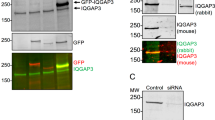Abstract
THE ras-encoded p21ras proteins bind GTP very tightly, but catalyse hydrolysis to GDP very slowly1. In humans, two genes encode proteins that stimulate this GTPase activity (GAP, or GTPase-activating proteins)2, one of relative molecular mass 120,000, referred to as p120-GAP, and another NF1-GAP, which is encoded by the neurofibromatosis type-1 gene3–5. Both GAPs are widely expressed in mammalian tissues6,7. Here we show that although they will both bind oncogenic mutants of p21ras, neither will stimulate their GTPase activity. NF1-GAP binds to the p21ras proteins up to 300 times more efficiently than p120-GAP. The two GAPs are inhibited to different extents by certain lipids: micromolar concentrations of arachidonate, phosphatidate and phosphatidyIinositol-4,5-bisphosphate affect only NF1-GAP. This inhibition does not compete with p21ras, and lipid-inactivated NF1-G AP can still bind p21ras. We used the detergent dodecyl maltoside, which inhibits only NF1-GAP, to distinguish between the two activities in cell extracts and found both types present together in several mammalian cell lines. In contrast, GAP activity in extracts of Xenopus oocytes was not affected by dodecyl maltoside. By these criteria, the mammalian cells contain both GAP activities and the oocytes have only p120-like GAP activity. These results indicate that more than one GAP regulates p21ras in the same cell.
This is a preview of subscription content, access via your institution
Access options
Subscribe to this journal
Receive 51 print issues and online access
$199.00 per year
only $3.90 per issue
Buy this article
- Purchase on Springer Link
- Instant access to full article PDF
Prices may be subject to local taxes which are calculated during checkout
Similar content being viewed by others
References
Barbacid, M. A. Rev. Biochem. 56, 779–827 (1987).
McCormick, F. Oncogene 5, 1281–1283 (1990).
Martin, G. A. et al. Cell 63, 843–849 (1990).
Xu, G. et al. Cell 63, 835–841 (1990).
Ballester, R. et al. Cell 63, 851–859 (1990).
Trahey, M. et al. Science 242, 1697–1700 (1988).
Buchberg, A. M., Cleveland, L. S., Jenkins, N. A. & Copeland, N. G. Nature 347, 291–294 (1990).
Trahey, M. & McCormick, F. Science 238, 542–545 (1987).
Adari, H., Lowy, D. R., Willumsen, B. M., Der, C. J. & McCormick, F. Science 240, 518–521 (1988).
Calés, C. Hancock, J. F., Marshall, C. J. & Hall, A. Nature 332, 548–551 (1988).
Vogel, U. S. et al. Nature 335, 90–93 (1988).
Yatani, A. et al. Cell 61, 769–776 (1990).
Bourne, H. R., Sanders, D. A. & McCormick, F. Nature 349, 117–127 (1991).
Tsai, M.-H., Yu, C.-L., Wei, F. S. & Stacey, D. W. Science 243, 522–526 (1989).
Tsai, M.-H., Hall, A. & Stacey, D. W. Molec. cell. Biol. 9, 5260–5264 (1989).
Yu, C.-L., Tsai, M.-H. & Stacey, D. W. Molec. cell. Biol. 10, 6683–6689 (1990).
Downward, J., Graves, J. D., Warne, P. H., Rayter, S. & Cantrell, D. A. Nature 346, 719–723 (1990).
Goldschmidt-Clermont, P. J., Machesky, L. M., Baldassare, J. J. & Pollard, T. D. Science 247, 1575–1578 (1990).
Birchmeier, C., Broek, D. & Wigler, M. Cell 43, 615–621 (1985).
Tanaka, K. et al. Molec. cell. Biol. 10, 4303–4313 (1990).
Tanaka, K., Lin, B. K., Wood, D. R. & Tamanoi, F. Proc. natn. Acad. Sci. U.S.A. 88, 468–472 (1991).
Zhang, K. et al. Nature 346, 754–756 (1990).
Shacter, E. Analyt. Biochem. 138, 416–420 (1984).
Furth, M. E., Davis, L. J., Fleurdelys, B. & Scolnick, E. M. J. Virol. 43, 294–304 (1982).
Author information
Authors and Affiliations
Rights and permissions
About this article
Cite this article
Bollag, G., McCormick, F. Differential regulation of rasGAP and neurofibromatosis gene product activities. Nature 351, 576–579 (1991). https://doi.org/10.1038/351576a0
Received:
Accepted:
Issue Date:
DOI: https://doi.org/10.1038/351576a0
This article is cited by
-
Using antisense oligonucleotides for the physiological modulation of the alternative splicing of NF1 exon 23a during PC12 neuronal differentiation
Scientific Reports (2021)
-
Evaluation of clinical findings and neurofibromatosis type 1 bright objects on brain magnetic resonance images of 60 Turkish patients with NF1 gene variants
Neurological Sciences (2021)
-
A model for RAS mutation patterns in cancers: finding the sweet spot
Nature Reviews Cancer (2018)
-
Neurofibromin Regulates Seizure Attacks in the Rat Pilocarpine-Induced Model of Epilepsy
Molecular Neurobiology (2016)
-
Identification of the NF1 gene mutation in Korean families with neurofibromatosis type 1
Genes & Genomics (2014)
Comments
By submitting a comment you agree to abide by our Terms and Community Guidelines. If you find something abusive or that does not comply with our terms or guidelines please flag it as inappropriate.



